
- Siin of the Alder, Hanai Shaman

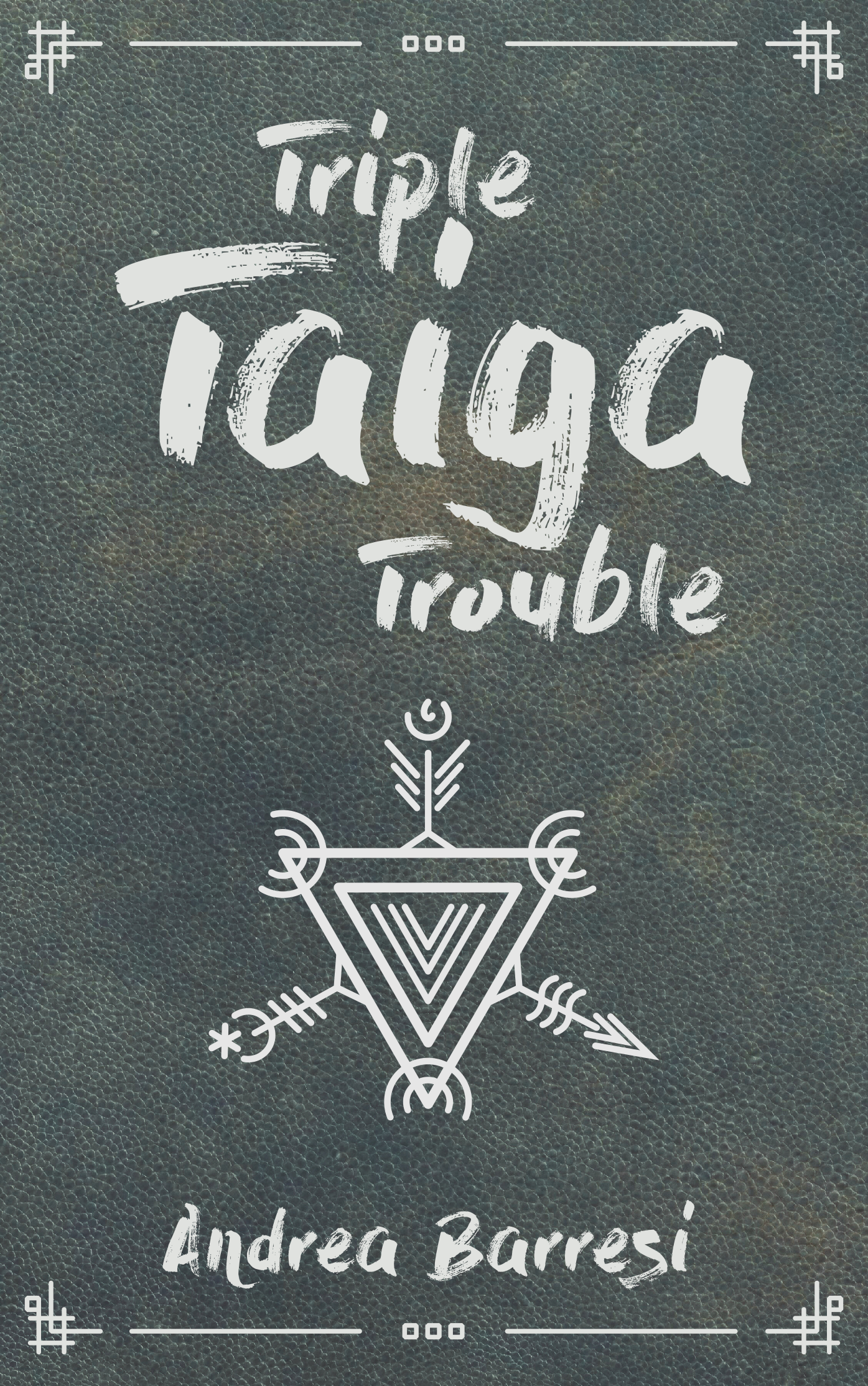
In a Neolithic taiga, two tribes of humans and one of dragons live in harmony, bound by the Taigan Pact.
The young and fiery Kuwirahk and the elder caretaker Erqi of the Birch join the wanderer Raan Tsis and explore the frozen valley and its peoples. On the backdrop of an ever-changing landscape where harsh seasons rule the Taiga, the three experience tribal rituals, fermented grudges and cunning solutions. On their path they will fight a threatening Empire, seeking to conquer the valley and exploit their resources.
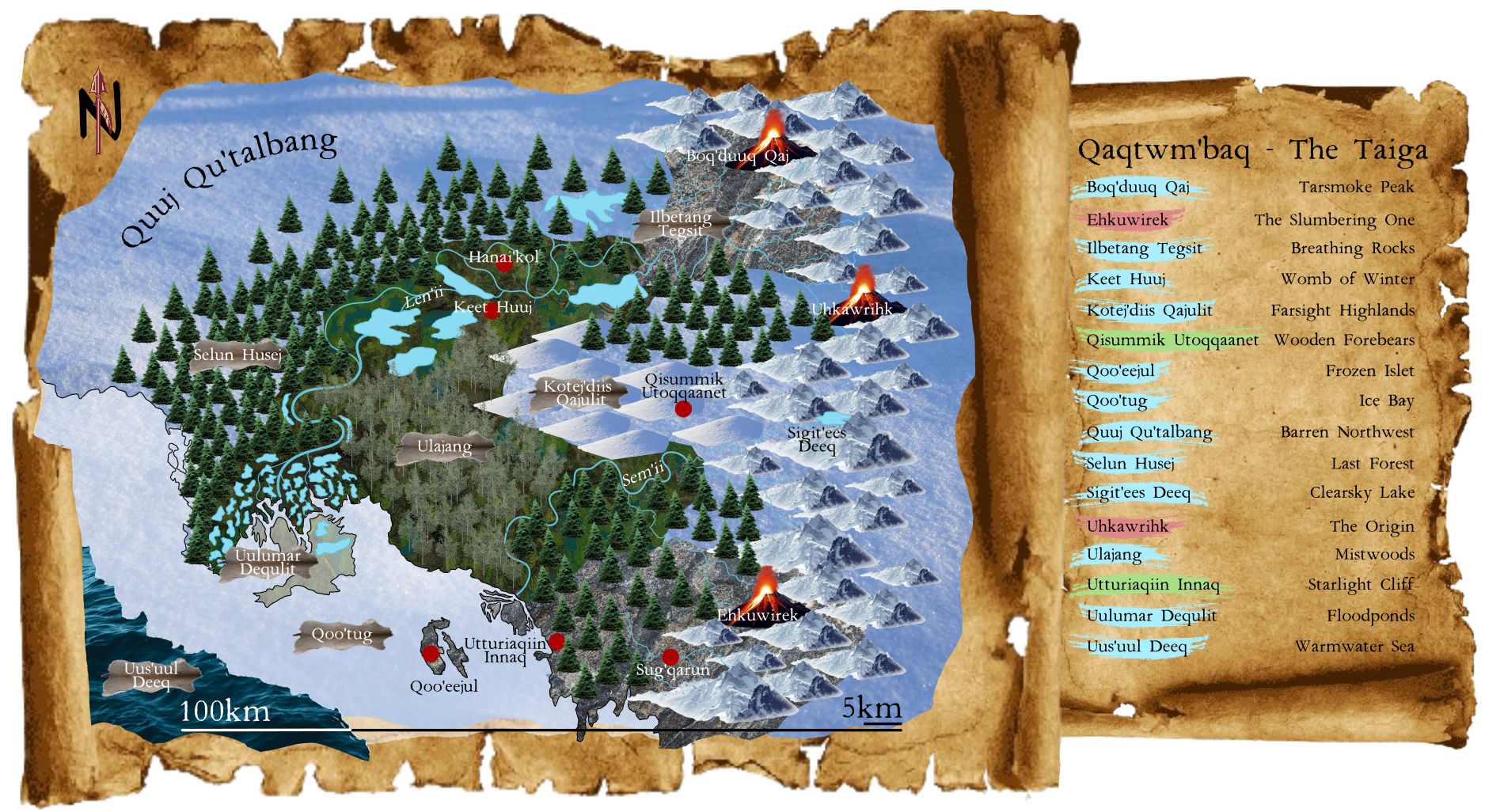
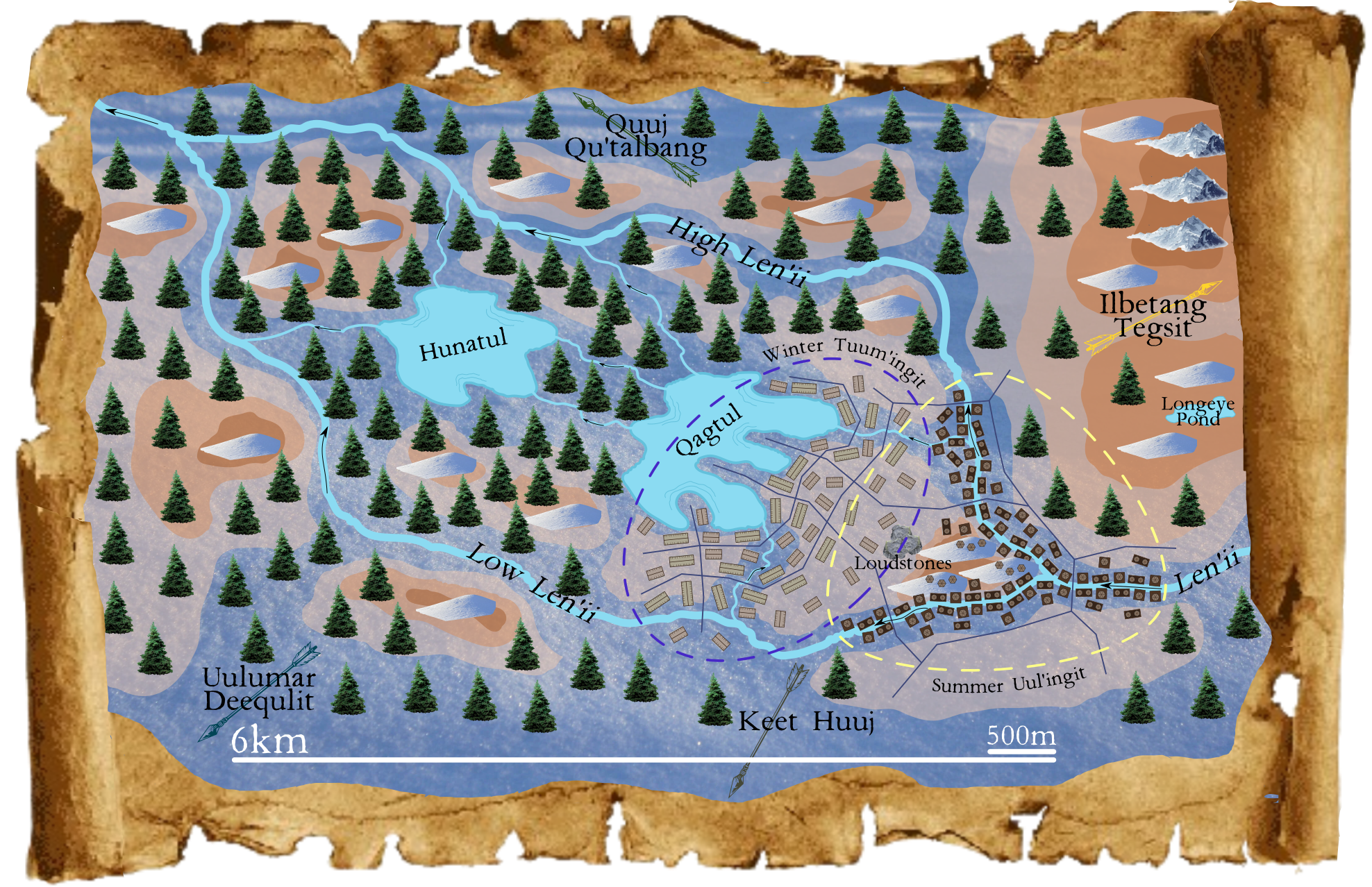
The Taiga, also called Qaqtwm'baq (IPA: /kak'tum bak/, lit. "cold land") by our people, is the valley where the Three Tribes live. Its harsh climate and long, dark winters discouraged many from settling in here, but despite the challenges we endure and thrive.
Shamans from faraway people (the Levei call them “scientists”) call our valley subarctic oceanic (Ecbd) along the coast (warm summer, severely cold winter) and subarctic continental (Eclc) inland (mild summer, very cold winter). This difference is due to proximity to the sea, which brings warm currents and air during the summer but reverses during the winter. Faraway from the coast these effects are less impactful, resulting in fresher summers and less rigid winters.
Many animals find their home along us:
...and mosquitoes. Too many mosquitoes.
 The Hanai Kin
The Hanai Kin

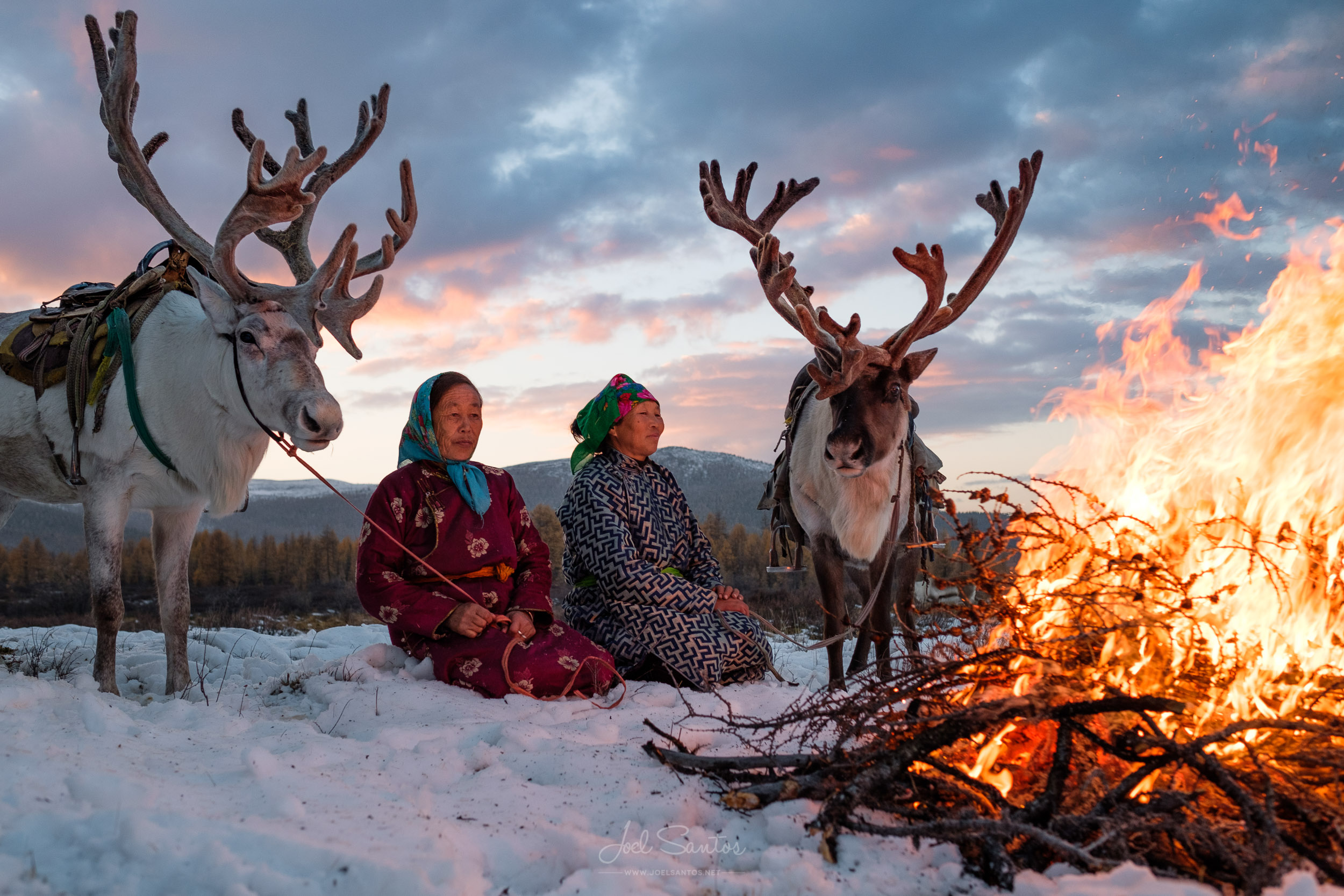
- Siin of the Alder, Hanai Shaman
Hanai are patient hunters, hard workers and good friends. Their craft is dependant on water bodies and their management, which they call waterscaping. They mainly live in the village of Hanai'kol and roam the valley only for susteinance and maintenance tasks. Due to isolation, they lack experience and knowledge about the world outside the valley, but given the harsh environment of the Taiga, they value cooperation and acknowledge that conflict and ostracism can be deadly. After the Levei settle in the valley, they learn many of their skills such as writing, eloquence and conflict de-escalation.
Women, more sedentary and practical, learn to live and build with water. Waterscapers, carpenters, potters and architects are mostly women, and they shape the environment symbiotically. Dredgers are a unique profession of the Hanai, mostly taken up by women, who bury food below the swamps to preserve it and then dig them out when needed.
Given their tolerance to carrying and walking, Hanai men are mostly hunters and fishers. Walking around the valley, they explore and observe the surroundings: this makes them creative musicians and poets. Male dredgers are tasked with burials and rituals, taking the role of shamans and spiritual guides.
After contact with the Ver’hk, siaqveji take up some professions for which there is shortage. Dredgers, actors and musicians are the main siaqvej roles, as well as scaleworkers and pigmenters to imitate draconic patterns. Nurses and caretakers are also primary siaqvej professions, arising after contact with other tribes. The Ver’hk allow only the siaqveji to nurse their eggs and hatchlings.
Hanai live and die with the swamp: the wetlands provide what they need, but they also take away what is neglected. Swamps become “doors to the afterlife”, a passage to the world of the dead: dredgers are tasked with burials and funerals to ensure the spirit of the deceased will be preserved in the swamp. In winter, the world of the dead penetrates into the world of the living through the swamp; on the Night of Deadfrost, when the first frost covers the water bodies, the doors to the afterlife are shut and the Hanai “live with the dead”. They believe the afterlife has temporarily replaced the world of the living, and they can meet their ancestors again until the ice melts. Some people “feel one with the dead”, since eating unearthed fermented food can cause botulism. Dying of botulism is interpreted as the person finding their place when the realm of the dead comes.
The balance is reestablished in spring: as the frost recedes, the doors to the afterlife open again and the Hanai are allowed back to the world of the living, when nature blooms and the valley becomes plentiful again. This is celebrated during the Thawing, a festival where the Hanai symbolically swim in the cold ponds as a way to cross back into the world of the living.
Hanai speak a unique language, an altered version of Yeniseian. Here are some example words:
 The Levei Nomads
The Levei Nomads


- Ipaqqe, Levei astronomer and shaman
Levei are observant, cunning and swift. Travelers by nature, their great experience with foraging, herding animals, dog training and forestry makes them extremely resourceful and knowledgeable. Due to their nomadic culture and sour experiences with other populations, they are skeptic and cold, but also quick-witted and masters of persuasion. After the Endless Wander, they abandon their tradition of male leaders and choose to settle in the Taiga to learn some of the Hanai ways before roaming the Outer World again.
Levei men are skilled crafters, tailors, woodworkers, writers, musicians and herders. Everything involving hands and manual skill generally pertains to men, even if many women choose to take up crafts with great results. In the past, Levei men used to lead the tribe by following the stars, but after the tragic Endless Wander they are no longer allowed to.
Women dedicate their experience to forestry and foraging. Generations of knowledge and experiments made them veteran alchemists, pharmacists and brewers, adept observant of both human bodies and plants. After the Endless Wander, women took up the task of astronomy and shamanism, never becoming leaders but instead counselors and holders of wisdom.
After contact with the Ver’hk, siaqveji take up some professions for which there is shortage. Scouts, astronomers and dancers are the main siaqvej roles. The most daring Levei siaqveji learn the unique skills of firebreathing and fire-eating. Nurses and caretakers are also primary siaqvej professions, arising after contact with other tribes. The Ver’hk allow only the siaqveji to nurse their eggs and hatchlings.
Levei believe that stars are reflections of humans’ future selves, and that their movement indicates the destination of the tribe across the world. They are often called “star-chasers” by other peoples (often with contempt). The trail of stars in the nightsky is referred to as the Bright Path, a road that takes generations to walk through and will eventually lead the Levei to an ascended life “without limits and without effort”. Stars in the Bright Path are believed to be Levei ancestors and dog pets who joined the procession in their afterlife.
Certain astronomical events have particular significance for the Levei. The winter solstice, also known as the Dayless Night, is a moment of celebration, clarity and storytelling, for the Bright Path is fully visible and the world is closest to the sky. The summer solstice, also known as the Nightless Day, is a moment of mourning: the way is lost and the Levei settle and fast until the sun sets again, praying for their ancestors to show the way again.
The two equinoxes are also significant days: during the spring equinox, also known as Blossoming, the Levei scatter around and gather flowers to share with each other and dance all night. The autumn equinox is called Day of the Moving Feet: the Levei get ready to travel once again, packing and gathering their items among music and dances. Items that cannot be brought along for the travel and dead Levei are burned in a bonfire during daylight.
Levei speak a unique language, an altered version of Tunumiisut. Here are some example words:
 The Ver’hk Thunder
The Ver’hk Thunder

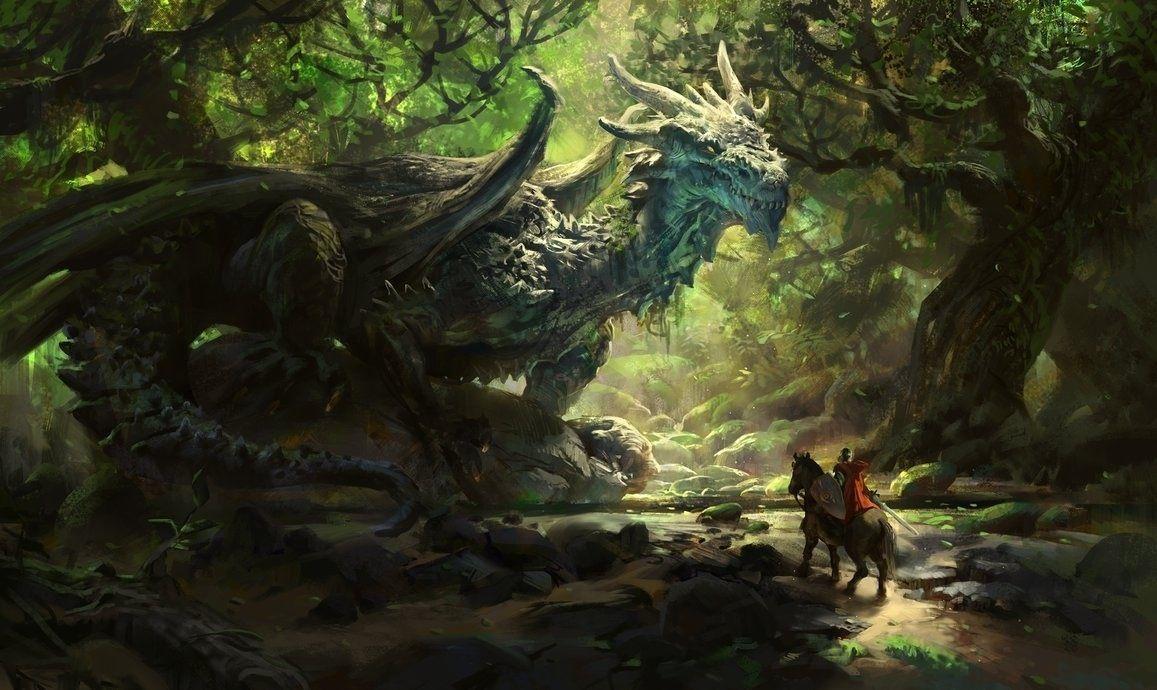
- Eruhkarsiik, Ver'hk Broodbearer
Ver’hk, being a clan of dragons, are majestic and powerful, but also fearful and stubborn. Their lifespans are several times longer than humans’, and as a consequence their decision-making and discussions can take months or years. Their memories are immense, but faulty in the short-term: dragons remember centuries with great detail, but struggle with human names and dates. Ver’hk initially lacked the capacity to put themselves in someone else’s shoes: only after contact with humans they learned emotions and empathy.
The only unbreakable rule of all dragon clans is the famous Thunders’ Pride: no dragon can ever be dominated, not even by other dragons. Individuals who transgress this sacred principle (either by imposing their authority over someone else or by allowing someone else to rule over them) are immediately exiled from their clans and only rarely admitted back. Another consequence of this principle is that Ver’hk disapprove being ridden by humans. To them, riding an animal is a sign of submission and oppression, and the humans’ relationship with dogs is seen with contempt.
Ver'hk are huge in size and have thick scales. Unlike other reptilians, they have bodily heat management problems: they need to keep themselves cool at all times or suffer heatstrokes. They hide during the hottest hours and hunt by night, when the air is cooler and warm-blood preys are easier to spot from above. This implies that if a dragon cannot keep themself cool enough, they might combust from within. Younglings tend to disregard these precautions and constantly fly and breathe out fire in order to cool down. This has led to the human belief that dragons are terrifying and dangerous; instead, due to their thermoregulation issues, adult dragons dislike fighting and always seek alternative ways of resolving conflicts, mostly fleeing to more suitable environments or areas.
A Ver'hk fire breath is given by a glans that produces a combustible liquid called sahkri (/sa'χri/, lit. "dragon drool"), which ignites when their overly warm breath is spit out with force. Excess sahkri can be expelled from their noses in liquid form; humans collect it and use it as combustible in their daily life. Dragons have been hunted also because of this prodigious liquid.
Ver'hk experience a form of seasonal hibernation called “brumation”: during late autumn they enter a state of prolonged dormancy, often hiding in secluded place or even underwater. This state persists until late winter, when they wake up from slumber and need to replenish their hunger.
Ver’hk are born without gender; they may pick one upon mating, according to a complex ritual that takes years. Every decade, the Broodbearer (usually the eldest dragon of the Thunder) suggests which season (usually spring or summer) Ver’hk should mate together. Two to five Ver’hk then form a group named “bonfire”: during the first year of mating, the bonfire agrees which genders are picked by each Ver’hk; at least a female is required in order to lay eggs. Following the Dragons’ Pride, no Ver’hk can be coerced into any gender or birthgiving. In the case of a female-less bonfire, the Ver’hk may mate anyway, but the Broodbearer will suggest another bonfire the following year or season to have at least one new egg.
When the Broodbearer is too old and weak to breathe fire, the whole pack of Ver’hk gathers to carry their body as high in the sky as possible. When the Broodbearer loses consciousness due to rarefied air, their body is dropped and the other Ver’hk cremate it while following its dive. The thermal shock between fire breaths and altitude temperatures crystallizes the body until it becomes a kind of obsidian (except its color matches the Broodbearer’s scale color at the moment of losing consciousness); the skeleton inside is kept intact. The crystallized body then crashes to the ground and shatters. This ritual is referred to as Rohk Angil, which translates to “Last Breath”. If the Broodbearer had black scales, their body turns to ashes instead and it dissolves in the air before touching the ground.
Ver’hk speak a unique language, an altered version of Unangam. Here are some example words:
- Eruhkarsiik, the Broodbearer
The siaqveji, (lit. "fire spirit" or "dragon soul" in Hanai) are people whose gender does not fit the standard binary of man or woman.
After contact with the Ver’hk Thunder, who have no gender and only pick one for mating purposes, some Hanai started noticing similarities with members of the Thunder. The word siaqveji originated from the first encounter of such people with the Broodbearer, who noticed their unruly spirit was more akin to a Ver’hk’s. Because of this spiritual connection, siaqveji are the only people allowed to handle Ver’hk eggs and nurse their hatchlings.
Siaqveji among the Hanai Kin take up professions like dredgers, actors, nurses, caretakers, scaleworkers and pigmenters.
Siaqveji among the Levei Nomads take up professions like scouts, dancers, caretakers, astronomers and fire-breathers.
- First verse of the Pact
The Taigan Pact, also known as Awhkuhkir (lit. "Threefold Respect"), Qiiavoqnuna Neriorsuut (lit. "Promise of the Taiga") or Qaqtwm'baas Ilqang (lit. "Path of the Taiga") by the respective tribes, is an agreement of mutual respect, help and nonviolence among the Hanai, Levei and Ver'hk to settle disputes and prevent conflicts over resources within the Taiga.
The main rules are:
DISCLAIMER: I dislike generative AI for a number of moral reasons; however I could not find decent no-copyright pictures of ethnically Siberian people. These are placeholders to give you an idea of the character until I can afford to commission an artist for actual portraits.
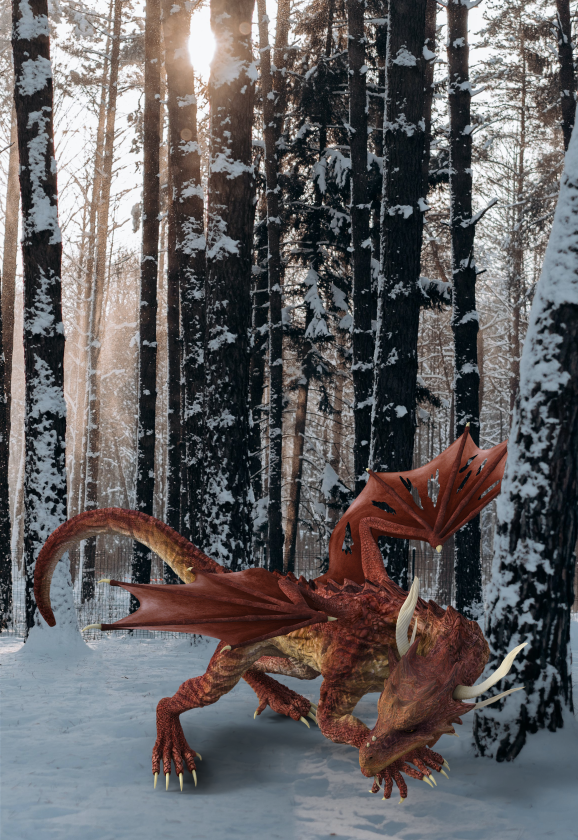
Kuwirahk (meaning “Quicktongue” in Ver’hk language) is a young dragon with copper scales and slender muzzle. Its left wing has been maimed during a reckless flight, after which it has lost the ability to fly. This makes it feel inferior to other Ver’hk and pressures it to always prove itself to others around it.
Being the sole youngling in the Thunder, it is entitled, needy, reckless and fickle, but also cheerful and easy-going. Its tantrums are badly tolerated by other Ver’hk, to the point it is still entrusted to Hanai caretakers to prevent further accidents until its attitude improves.
It likes to roam around and pull pranks on humans; its favourite food is frozen taimen.
It hates being scolded by other Ver’hk and treated as a lesser dragon due to its age, flightlessness and bad temper.
Erqi of the Birch is an elder Hanai siaqvej. Living in Hanai'kol for most of their life, they have learned the complex craft of burying and fermenting food under the frozen bogs of the Taiga. As a siaqvej, they also take care of newly hatched Ver’hk.
They are one of the eldest dredgers among the Hanai, and their experience and wisdom are highly respected. Despite their age, they haven't explored much of the Taiga; this resulted in a mix of longing and dread of passing away before seeing more of the world around them.
They like to sniff, taste and touch everything around them; their favourite food is kengassiin (crossbill meat fermented in seal skin).
They hate not being listened to and doing things without careful consideration.
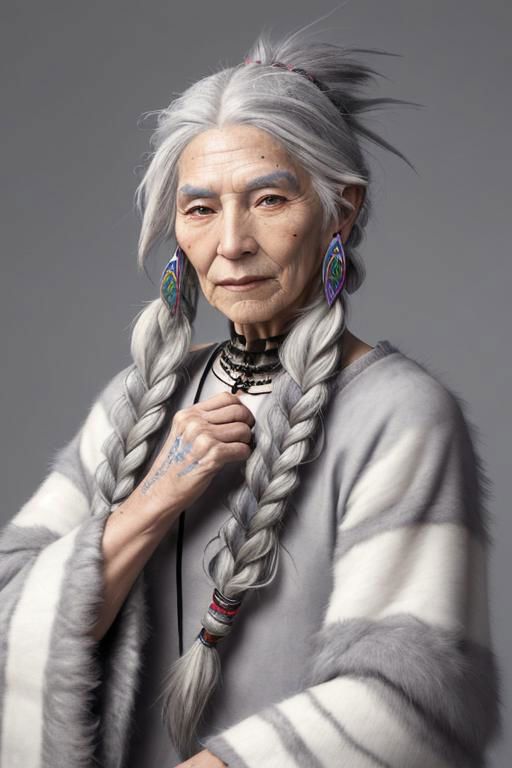
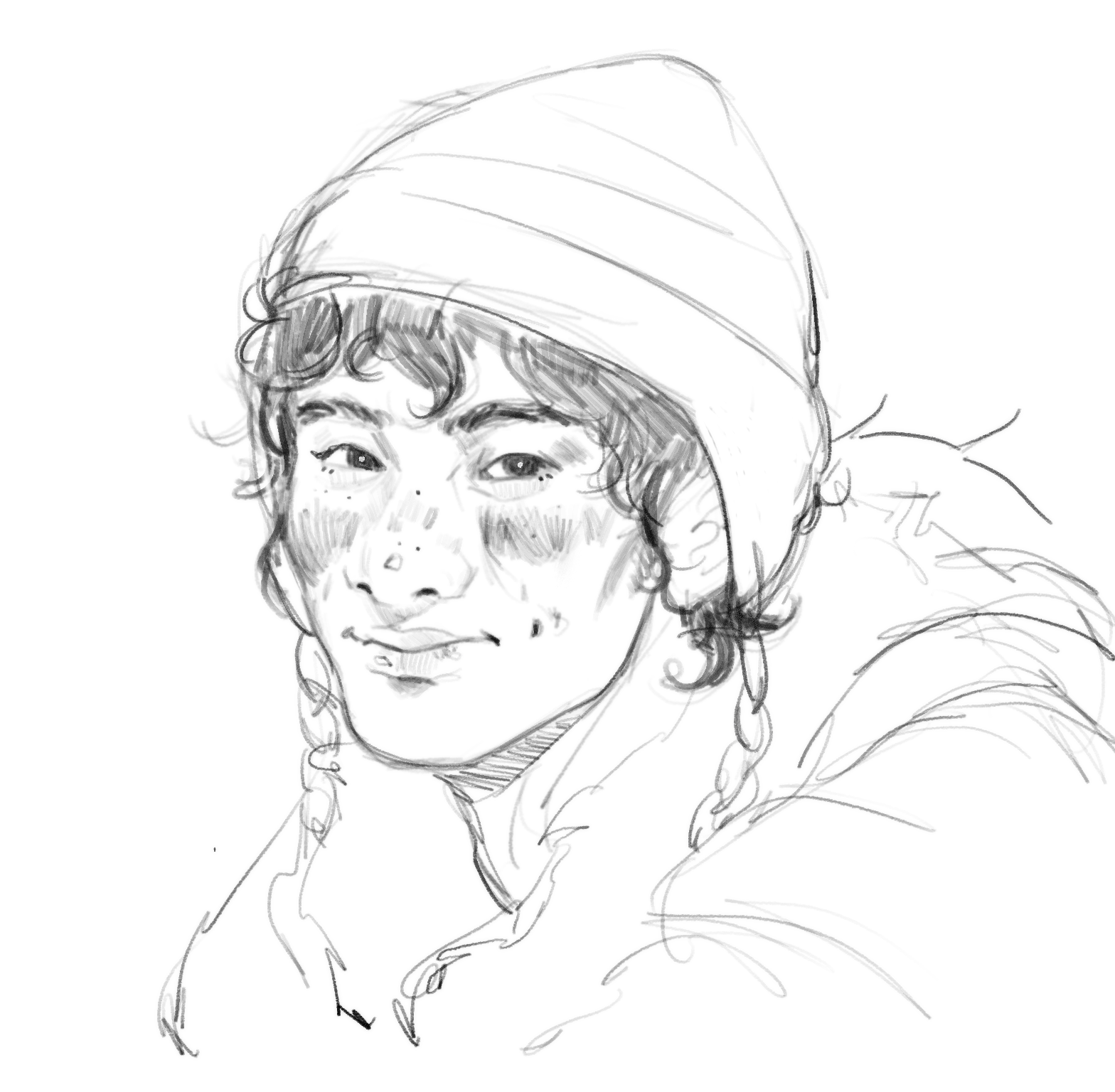
Raan Tsis is a young Levei from the Forest Clan. He lived with his tribe in the Selun Husej, where he was trained as a carpenter and forager. After completing his adulthood ritual, from which he got a constellation tattoo on his right arm, he decided to take a year away from his clan to travel the Taiga and become a musician like his grandmother.
Raan is observant, curious and reflective, always aware of his surroundings, the environment around him and the sky above. Everything he comes in contact with is an inspiration, which he aims to turn into music to convey joy and wonder to the people of the Taiga.
He likes to play with his qoomus, a keepsake from his grandma, and admire beautiful sceneries; their favourite food is goat cheese, although he has a soft spot for Hanai pemiqan, a fermented delicacy of meat and berries.
They hate loud confrontations and losing directions.
⏫ Back to the Exploration Bar!
This work is licensed under a Creative Commons 4.0 License.
